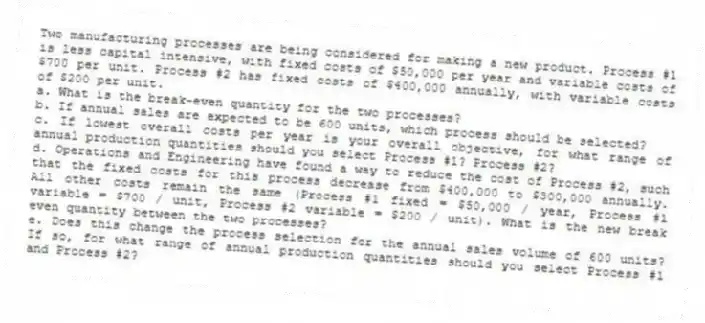
Two manufacturing processes are being considered for making a new product. Process #1 is less capital intensive, with fixed costs of $50,000 per year and variable costs of $700 per unit. Process #2 has fixed costs of $400,000 annually, with variable costs of $200 per unit.
a. What is the break-even quantity for the two processes?
b. If annual sales are expected to be 600 units, which process should be selected?
c. If lowest overall costs per year is your overall objective, for what range of annual production quantities should you select Process #1? Process #2?
d. Operations and Engineering have found a way to reduce the cost of Process #2, such that the fixed costs for this process decrease from $400,000 to $300,000 annually. All other costs remain the same (Process #1 fixed = $50,000 / year, Process #1 variable = $700 / unit, Process #2 variable = $200 / unit). What is the new break even quantity between the two processes?
e. Does this change the process selection for the annual sales volume of 600 units? If so, for what range of annual production quantities should you select Process #1 and Process #2?
Correct Answer:
Verified
View Answer
Unlock this answer now
Get Access to more Verified Answers free of charge
Q67: Suppose that competitive priorities call for offering
Q68: Higher volume in a process is generally
Q69: Scenario 2.6
You currently purchase a part used
Q70: _ automation produces only one type of
Q71: Which one of the following statements about
Q73: An entrepreneur considers three possibilities for the
Q74: _ is the mix of equipment and
Q75: A higher level of fixed automation can
Q76: _ reflects the ways in which customers
Q77: Which statement about economies of scope is
Unlock this Answer For Free Now!
View this answer and more for free by performing one of the following actions

Scan the QR code to install the App and get 2 free unlocks

Unlock quizzes for free by uploading documents